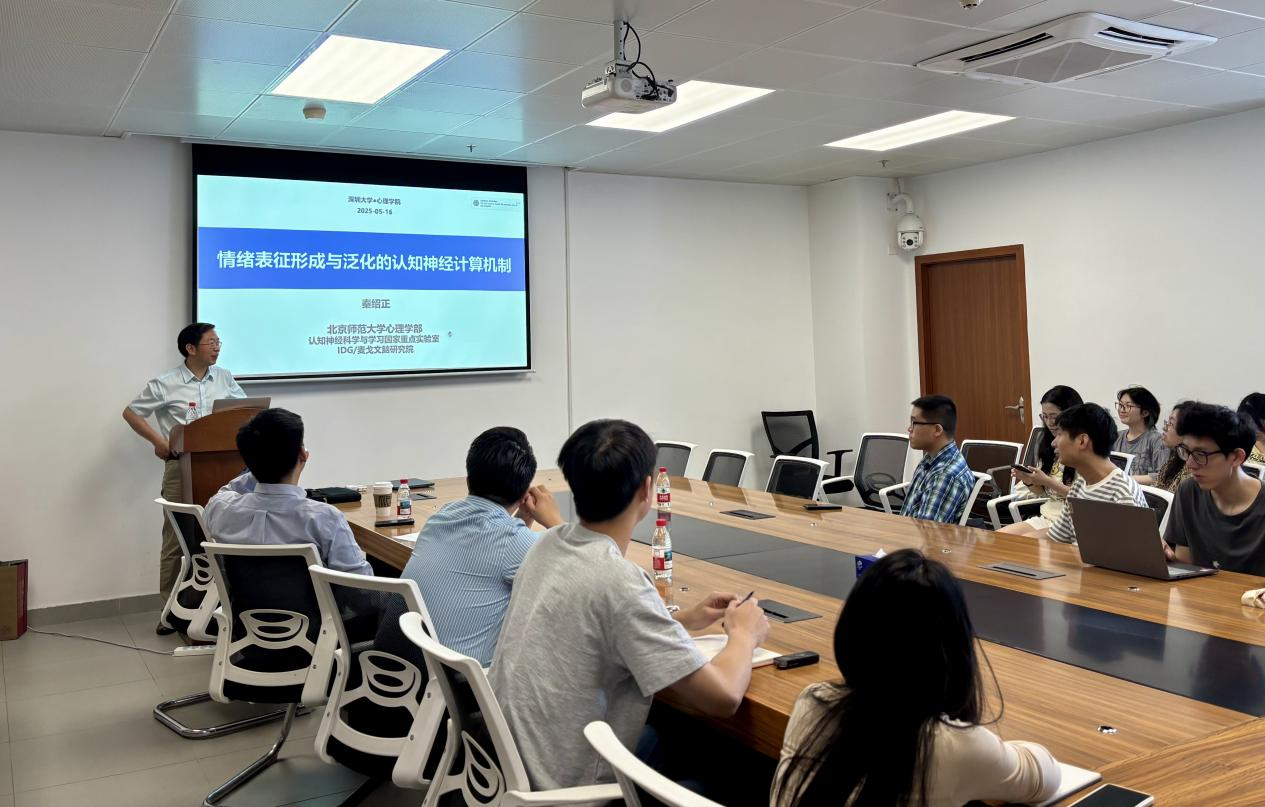On the morning of May 16th,Professor Shaozheng Qin, a research fellow at the State Key Laboratory of Cognitive Neuroscience and Learning at Beijing Normal University, delivered a lecture at the School of Psychology, Shenzhen University. The talk, titled "Computational Mechanisms of Emotional Representation Formation and Generalization in Cognitive Neuroscience," presented a series of studies on emotion. Professor Qin's insights offered students and faculty valuable perspectives and deeper reflections on emotional cognition and its underlying neural mechanisms.

Professor Qin’s lecture focused on emotional cognition and neuroscience, primarily exploring how emotions are constructed, how the brain processes emotional information, and the experimental designs used in this research. He began by introducing the background of his work, noting that his research centers on affective responses to stress and cognitive neuroscience, with particular emphasis on the prevention and intervention of emotional problems. Professor Qin also delved into the role of emotions in human evolution, highlighting their critical importance in survival and environmental adaptation.
Professor Qin went on to elaborate on the functions and characteristics of emotions. He emphasized that emotions are instinctive responses preserved through human evolution, enabling individuals to better adapt to both natural and social environments. However, emotions can also lead to negative outcomes such as anxiety and depression. Notably, Professor Qin pointed out the attention-focusing nature of emotions, which are typically accompanied by physiological responses. This complexity makes emotional experiences particularly difficult for artificial intelligence to fully simulate.
In terms of theoretical frameworks, Professor Qin introduced the constructivist theory, which posits that emotions are complex constructs formed by the brain through the integration of multiple sources of information, encompassing both basic emotions and physiological responses. He also discussed cognitive theories, which emphasize the tight coupling between emotion and cognition, highlighting the interactive nature of multitasking rather than the control of isolated tasks.
In the experimental design section, Professor Qin adopted a constructivist perspective to investigate how multidimensional information is integrated into stable emotional representations. In his experiments, he employed virus-related images as stimuli and used both behavioral tasks and neuroimaging techniques to measure participants’ responses to threat intensity and uncertainty. The study featured a two-dimensional learning task,threat intensity and uncertainty,as key variables, aiming to observe how participants generalized these emotional cues to novel, unexperienced contexts.
Behavioral data indicated that participants were able to effectively integrate information from both dimensions to make judgments, and that a linear model outperformed single dimension models in explaining the results. Neuroimaging findings further revealed that brain regions such as the hippocampus and the anterior cingulate cortex played key roles in the process of emotional integration.
In the modeling section, Professor Qin introduced a basis function–based modeling approach, aiming to describe the spatial representation of emotions through mathematical models. He further explored how basis functions can optimize representation in high-dimensional spaces and analyzed their application across different brain regions.
Regarding future research directions, Professor Qin expressed his intention to further investigate the temporal dimension of emotional representations and individual differences across participants. He also plans to integrate artificial intelligence technologies to develop multi-agent experiential models, aiming to explore mechanisms of emotional sharing and the capacity for empathy.
In the discussion and Q&A session, Professor Qin engaged in in-depth exchanges with the audience on topics such as the application of basis functions and the construction of cognitive maps. He emphasized the division of labor and collaboration among different brain regions in emotional processing, and reflected on the challenges and directions for future research.